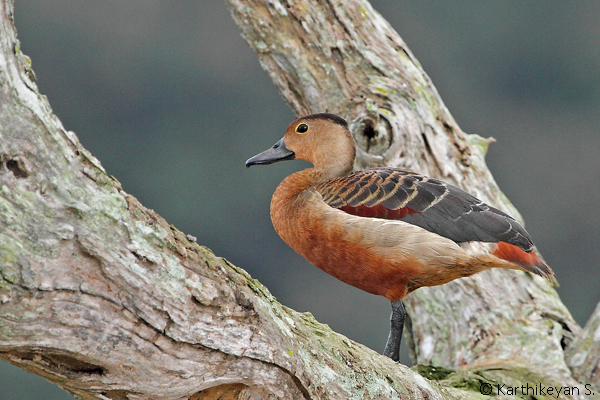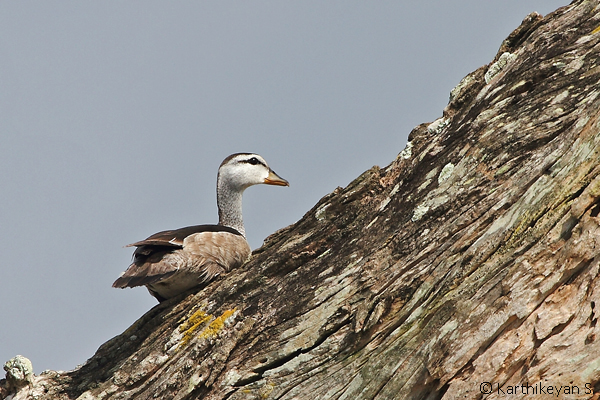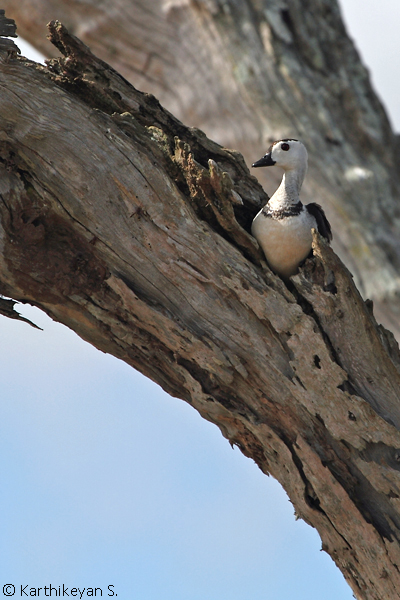Ducks. For most, including birdwatchers, the moment the word is heard we are compelled to imagine a waterbody where one can see these birds swimming/floating on the waters. True. Ducks are indeed birds whose life is tied to water. They have webbed feet – an adaptation to swim in the water efficiently; a plumage coated with oil making it waterproof; they can dive or dabble in the water in search of food.
When on land, their ungainly waddling gait is all too familiar to us. With a lifestyle that revolves around water, it should be expected that they also breed in the vicinity of water. And most do. They typically nest on the banks of the waterbody where they make a nest amid vegetation. The plants in the vicinity themselves are employed to build the nest and sometimes feathers, to line the nest.
However, there are ducks that have taken to nesting in trees. The colourful Wood Duck from USA is perhaps one familiar example. However, in India there are 2 species of ducks that have taken to nesting in trees – the Lesser Whistling Teal and the Cotton Teal (now called the Cotton Pygmy-goose).
Some years ago while on the Kabini backwaters, as is my routine, I was scanning the dead trees (the Kabini backwaters has several dead trees that raise their heads above the water level) and was hoping to make some images of cormorants and darters that regularly use these dead trees for just hanging around and also to build their nest. I was completely taken by surprise when for the first time I espied what looked like a duck. A quick glance through my binoculars revealed that it was a Lesser Whistling Teal.

Having spent some time looking at this beautiful duck and photographing it, we moved on to the accompaniment of the sounds of the boat while enjoying the vistas that one misses from the jeep. I scanned the tree stumps with binoculars as we approached one for anything of interest.
Having asked for the engine to be killed, I scanned another tree trunk for suspected movement. The boat drifted and the angle of observation changed. I missed it. Or, had I imagined something?
The boatman started the engine and as we continued along, we saw an Osprey and a Peregrine Falcon too. Soon it was time to head back. As we approached the tree trunk where I ‘saw’ something, I checked again. There it was – a Cotton Teal!

I got a good look at the bird. I had only seen these beautiful birds on the water feeding among floating vegetation at various locations over the years. But seeing one sitting on the tree was a treat. It suddenly dawned on me that these, along with the Lesser Whistling Teals, are tree hole nesters. Out of greed I scanned the tree and bingo – another treat! A drake of the Cotton Teal was peeping from a hollow in the tree trunk.

I made a dash to the library to read more about these two ducks that had surprised me. The obvious choice of reference was the works of Salim Ali.
The Lesser Whistling Teal, he says, nests in natural hollows of ancient tree-trunks. At times, they are also known to use old nests of kites, herons and crows. Occasionally they also build nests on the ground among reeds or among scrub bordering the waterbody. For the Cotton Teal, the nest is a natural hollow in a tree trunk standing in or near water. He goes on to say that there are records of them choosing to nest in a hole in a building! And, not just that. The adult was seen pushing thirteen ducklings out of this nest!! The ducklings fluttered when they were close enough to the ground and landed safely.
What a way to begin life? Is this what is called a great head start?!